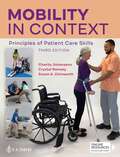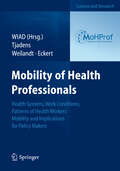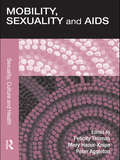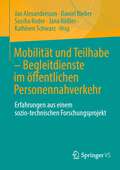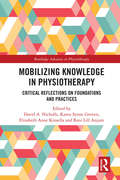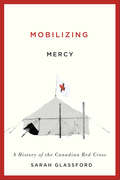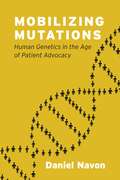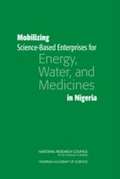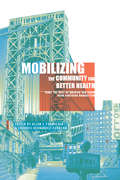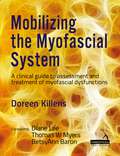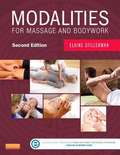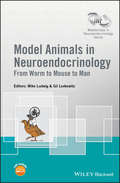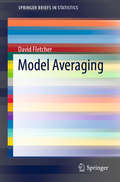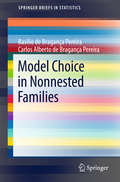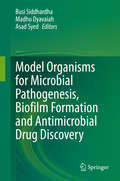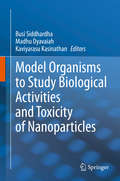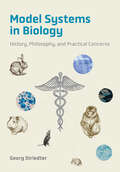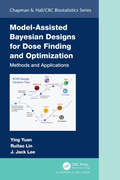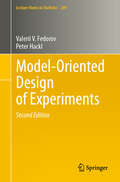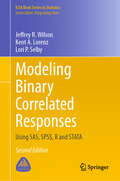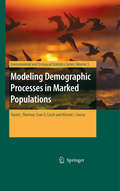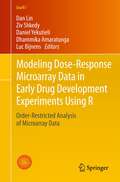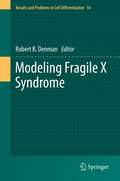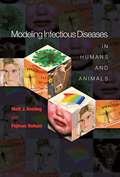- Table View
- List View
Mobility in Context: Principles of Patient Care Skills
by Charity Johansson Pt Crystal Ramsey PT DPT Susan A. Chinworth PtMaximize patient care skills Rely on this state-of-the-art, multimedia resource to help you navigate confidently in both common and complex clinical situations. Mastering patient care skills will ground you in fundamental rehabilitation principles; help you establish a culture of patient-centered care; and develop essential your clinical problem-solving and critical-thinking skills. You’ll also learn how to help your patients progress toward greater mobility and independence. Over 750 full-color photographs and illustrations make every concept crystal clear.
Mobility of Health Professionals
by Wissenschaftliches Institut Der Frits Tjadens Josef Eckert Caren WeilandtThis book on mobility of health professionals reviews, analyses and summarises published information and data as well as collected interview data from stake holders, including politicians, policy makers, health service managers and migrant health workers. It is based on the research carried out under the umbrella of the EU-funded project "Mobility of Health Professionals (MoHProf). The partners involved in the MoHProf project gathered evidence from 25 countries around basic questions and knowledge gaps relating to the international migration of health professionals, which involved an analysis of migration flows and evaluation of policies addressing migration. This book provides a comprehensive description and analysis of the mobility streams, the motives and driving forces behind them and the impact on and challenges for health systems and draws conclusions and provides recommendations for future strategic planning, monitoring and the management of mobility of health professionals as well as further research and policy development needs.
Mobility, Sexuality and AIDS (Sexuality, Culture and Health)
by Peter Aggleton Felicity Thomas Mary Haour-KnipeOver the past two decades, population mobility has intensified and become more diverse, raising important questions concerning the health and well-being of people who are mobile as well as communities of origin and destination. Ongoing concerns have been voiced about possible links between mobility and HIV, with calls being made to contain or control migrant populations, and debate linking HIV with issues of global security and surveillance being fuelled. This volume challenges common assumptions about mobility, HIV and AIDS. A series of interlinked chapters prepared by international experts explores the experiences of people who are mobile as they relate to sexuality and to HIV susceptibility and impact. The various chapters discuss the factors that contribute to the vulnerability of different mobile groups but also examine the ways in which agency, resilience and adaptation shape lived experience and help people protect themselves throughout the mobility process. Looking at diverse forms of migration and mobility – covering flight from conflict, poverty and exploitation, through labour migration to ‘sex tourism’ – the book reports on research findings from around the world, including the USA, the UK, sub-Saharan Africa, Australia, Central America and China. Mobility, Sexuality and AIDS recognises the complex relationships between individual circumstances, population mobility and community and state response. It is invaluable reading for policy makers, students and practitioners working in the fields of migration, development studies, anthropology, sociology, geography and public health.
Mobilität und Teilhabe – Begleitdienste im öffentlichen Personennahverkehr: Erfahrungen aus einem sozio-technischen Forschungsprojekt
by Daniel Bieber Sascha Roder Jan Alexandersson Jana Rößler Kathleen SchwarzDas Mobilitätsprojekt „mobisaar“ verbessert die Teilhabe von mobilitätseingeschränkten Menschen und Menschen mit Behinderungen durch den Einsatz von Lots*innen und mit Technikunterstützung durch Apps. Das in vier saarländischen Landkreisen erfolgreich umgesetzte BMBF-Projekt wird nach 5 Jahren Laufzeit 2020 finalisiert und bietet einen guten Einblick in die Konzepte, Strukturen und Schulungsideen des kostenfreien Begleitdienstes im kleinsten Flächenland Deutschlands sowie dessen Auswirkungen auf den ÖPNV.
Mobilizing Knowledge in Physiotherapy: Critical Reflections on Foundations and Practices (Routledge Advances in Physiotherapy)
by David A. Nicholls; Karen Synne Groven; Elizabeth Anne Kinsella; Rani Lill AnjumMobilizing Knowledge in Physiotherapy: Critical Reflections on Foundations and Practices is a collection of 15 collaboratively written critical essays, by 39 authors from 15 disciplines and seven countries. The book challenges some of the most important contemporary assumptions about physiotherapy knowledge, and makes the case for much more critical theory, practice, and education in physiotherapy health and social care. The book challenges the kinds of thinking that have traditionally bounded the profession and highlights the ways in which knowledge is now increasingly fluid, complex, and diffuse. The collection engages a range of critical social theories and interdisciplinary perspectives from within and without the profession. It includes sections focusing on evidence, practice, patient perspectives, embodiment, culture, diversity, digital worlds, and research methods. The book makes an important contribution to how we think about mobilizing knowledge, and it speaks to a diverse audience of academics, practitioners, educators, policy-makers, and students - both within physiotherapy and from a range of related health and social care disciplines. This book will be a useful reference for scholars interested in conceptions of professional knowledge, and the theory of professional education and practice in physiotherapy and beyond.
Mobilizing Mercy: A History of the Canadian Red Cross
by Sarah GlassfordFor more than a century the Canadian Red Cross Society has provided help and comfort to vulnerable people at home and abroad. In the first detailed national history of the organization, Sarah Glassford reveals how the European-born Red Cross movement came to Canada and took root, and why it flourished. From its origins in battlefield medicine to the creation of Canada’s first nationwide free blood transfusion service during the Cold War, Mobilizing Mercy charts crucial organizational changes, the influence of key leaders, and the impact of social, cultural, political, economic, and international trends over time. Glassford shows that the key to the Red Cross's longevity lies in its ability to reinvent itself by tapping into the concerns and ambitions of diverse groups including militia doctors, government officials, middle-class women, and schoolchildren. Through periods of war and peace, the Canadian Red Cross pioneered new services and filled gaps in government aid to become a ubiquitous agency on the wartime home front, a major domestic public health organization, and a respected provider of international humanitarian aid. Opening a window onto the shifting relationship between voluntary organizations and the state, Mobilizing Mercy is a compelling portrait of a major humanitarian organization, its people, and its ever-evolving place in Canadian society.
Mobilizing Mercy: A History of the Canadian Red Cross (McGill-Queen's/Associated Medical Services Studies in the History of Medicine, Health, and Society #45)
by Sarah GlassfordFor more than a century the Canadian Red Cross Society has provided help and comfort to vulnerable people at home and abroad. In the first detailed national history of the organization, Sarah Glassford reveals how the European-born Red Cross movement came to Canada and took root, and why it flourished. From its origins in battlefield medicine to the creation of Canada’s first nationwide free blood transfusion service during the Cold War, Mobilizing Mercy charts crucial organizational changes, the influence of key leaders, and the impact of social, cultural, political, economic, and international trends over time. Glassford shows that the key to the Red Cross's longevity lies in its ability to reinvent itself by tapping into the concerns and ambitions of diverse groups including militia doctors, government officials, middle-class women, and schoolchildren. Through periods of war and peace, the Canadian Red Cross pioneered new services and filled gaps in government aid to become a ubiquitous agency on the wartime home front, a major domestic public health organization, and a respected provider of international humanitarian aid. Opening a window onto the shifting relationship between voluntary organizations and the state, Mobilizing Mercy is a compelling portrait of a major humanitarian organization, its people, and its ever-evolving place in Canadian society.
Mobilizing Mutations: Human Genetics in the Age of Patient Advocacy
by Daniel NavonWith every passing year, more and more people learn that they or their young or unborn children carries a genetic mutation. But what does this mean for the way we understand a person? Today, genetic mutations are being used to diagnose novel conditions like the XYY, Fragile X, NGLY1 mutation, and 22q11.2 Deletion syndromes, carving out rich new categories of human disease and difference. Daniel Navon calls this form of categorization “genomic designation,” and in Mobilizing Mutations he shows how mutations, and the social factors that surround them, are reshaping human classification. Drawing on a wealth of fieldwork and historical material, Navon presents a sociological account of the ways genetic mutations have been mobilized and transformed in the sixty years since it became possible to see abnormal human genomes, providing a new vista onto the myriad ways contemporary genetic testing can transform people’s lives. Taking us inside these shifting worlds of research and advocacy over the last half century, Navon reveals the ways in which knowledge about genetic mutations can redefine what it means to be ill, different, and ultimately, human.
Mobilizing Science-Based Enterprises for Energy, Water, and Medicines in Nigeria
by National Research Council of the National AcademiesDeveloped in collaboration with the Nigerian Academy of Science, this report explores the ways in which science-based private enterprises can be created and encouraged in Nigeria and other developing countries to provide products and services that government is unable to supply in a timely and sustainable manner. Focusing on three critical challenges to health and development-- safe water, electrical lighting, and malaria therapy—the report identifies a sample technology to address each of these challenges with potential for commercialization in Nigeria and Africa, and uses that sample technology to identify opportunities and barriers to creating the science-based enterprises in Nigeria.
Mobilizing the Community for Better Health: What the Rest of America Can Learn from Northern Manhattan
by Lourdes Hernandez-Cordero Eds. Formicola AllanFrom 1999 to 2009, The Northern Manhattan Community Voices Collaborative put Columbia University and its Medical Center in touch with surrounding community organizations and churches to facilitate access to primary care, nutritional improvement, and smoking cessation, and to broker innovative ways to access healthcare and other social services. This unlikely partnership and the relationships it forged reaffirms the wisdom of joining "town and gown" to improve a community's well-being.Staff members of participating organizations have coauthored this volume, which shares the successes, failures, and obstacles of implementing a vast community health program. A representative of Alianza Dominicana, for example, one of the country's largest groups settling new immigrants, speaks to the value of community-based organizations in ridding a neighborhood of crime, facilitating access to health insurance, and navigating the healthcare system. The editors outline the beginnings and infrastructure of the collaboration and the relationship between leaders that fueled positive outcomes. Their portrait demonstrates how grassroots solutions can create productive dialogues that help resolve difficult issues.
Mobilizing the Myofascial System: A clinical guide to assessment and treatment of myofascial dysfunctions
by Doreen KillensFascia has become the new buzzword in the field of rehabilitation and movement re-education. Until recently its contribution to musculoskeletal dysfunction had been underestimated. We know now that fascia plays an important role in health, wellbeing and mobility. It transmits the power of the muscles, communicates with the nervous system and serves as a sense organ. Many different groups of professionals are now exploring the world of fascia, as evidenced by the explosion of research in this field. However, many physical therapists are still unfamiliar with fascia and continue to think of it as the 'dead packing material' that is pushed aside during dissections in order to visualize the 'important stuff' like muscles and nerves. Physical therapists with their varied skill-set in manual therapy techniques are well-placed to take on this important tissue. Mobilization of the Myofascial System aims to help them to do that.Mobilization of the Myofascial System (MMS), the technique described in this book, has its origins in manual physical therapy for the articular, muscular and neural systems. Tom Myers' book Anatomy Trains, which examines the myofascial meridians for manual and movement therapists, has been the framework and inspiration for the development of MMS. In this book the author outlines the theory and pathophysiology of fascial dysfunctions. A full description of the MMS assessment and treatment approach is given as well as guidance on ways in which it may be integrated into the other methods normally used by manual therapists. Subsequent chapters offer full descriptions and color photos of the MMS techniques. The chapters are organized into various anatomical regions simply to facilitate learning. These divisions are, of course, artificial, as fascia is a continuum, from the top of the head, down to the toes.Mobilization of the Myofascial System is primarily intended for physical therapists who have been trained in manual therapy, but it will also be valuable for osteopaths, chiropractors, massage therapists, structural integrators and other body workers who are seeking an alternative way to work with this important and fascinating tissue.
Modalities for Massage and Bodywork
by Elaine StillermanIdeal for both classroom and practice, Modalities for Massage & Bodywork, 2nd Edition presents 23 modalities of bodywork, their history, development, effects, benefits, contraindications, basic curricula and certification requirements. Updated photos and illustrations, critical thinking questions, and flash cards give you a better picture of today's massage best practices. Evolve companion website provides matching activities, flash cards, answers to multiple-choice questions, weblinks and video demonstrations of various modalities covered in the text to make learning more interactive. Case histories in each chapter illustrate the effects of the modality within a therapeutic context, creating the opportunity for integrative, clinical reasoning that helps prepare you for work in the various modalities. Student objectives and key terms at the start of each chapter provides a framework for what to expect and what to focus on with each chapter. In My Experience boxes provide personal insights about specific techniques from experts in the field. Full-color design and techniques shown with photos and illustrations enhance understanding and comprehension of each modality. Multiple-choice test questions at the end of each chapter with answers on the Evolve website help you measure your understanding of the modality and obtain instant feedback from the answer key that includes rationales. Suggested readings, resources and references in each chapter offer robust resources for you to further research each modality. Clinically relevant boxes and tables highlight important information. NEW Modalities chapters provide you with a greater awareness of the opportunities and options available as they pursue a massage therapy career and practitioners with more practical information they can apply to their work. NEW! Student resources on Evolve supplement the classroom experience and ensures you retain the material in the text. 23 different body techniques are introduced to help you learn about different modalities you may want to pursue and reaffirm your knowledge of techniques. More than 2 hours of video on the Evolve website bring the modalities to life and help put the text instructions in perspective. NEW! Updated content, photos and illustrations equip you with the latest information and visuals on modalities from experts in the field that reflect current practices in the field and the needs and wants of massage therapy practitioners and students. NEW! Critical thinking questions added to each chapter actively engage and challenge your reasoning skills. NEW! Additional review questions added to each chapter supply you with more opportunities to review what you have learned and test your knowledge.
Model Animals in Neuroendocrinology: From Worm to Mouse to Man (Wiley-INF Masterclass in Neuroendocrinology Series)
by Mike Ludwig Gil LevkowitzModel Animals in Neuroendocrinology: From Worm to Mouse to Man offers a masterclass on the opportunities that different model animals offer to the basic understanding of neuroendocrine functions and mechanisms of action and the implications of this understanding. The authors review recent advances in the field emanating from studies involving a variety of animal models, molecular genetics, imaging technologies, and behavior assays. These studies helped unravel mechanisms underlying the development and function of neuroendocrine systems. The book highlights how studies in a variety of model animals, including, invertebrates, fish, birds, rodents and mammals has contributed to our understanding of neuroendocrinology. Model Animals in Neuroendocrinology provides students, scientists and practitioners with a contemporary account of what can be learnt about the functions of neuroendocrine systems from studies across animal taxonomy. This is the seventh volume in the Masterclass in Neuroendocrinology Series, a co-publication between Wiley and the INF (International Neuroendocrine Federation) that aims to illustrate highest standards and encourage the use of the latest technologies in basic and clinical research and hopes to provide inspiration for further exploration into the exciting field of neuroendocrinology.
Model Averaging (SpringerBriefs in Statistics)
by David FletcherThis book provides a concise and accessible overview of model averaging, with a focus on applications. Model averaging is a common means of allowing for model uncertainty when analysing data, and has been used in a wide range of application areas, such as ecology, econometrics, meteorology and pharmacology. The book presents an overview of the methods developed in this area, illustrating many of them with examples from the life sciences involving real-world data. It also includes an extensive list of references and suggestions for further research. Further, it clearly demonstrates the links between the methods developed in statistics, econometrics and machine learning, as well as the connection between the Bayesian and frequentist approaches to model averaging. The book appeals to statisticians and scientists interested in what methods are available, how they differ and what is known about their properties. It is assumed that readers are familiar with the basic concepts of statistical theory and modelling, including probability, likelihood and generalized linear models.
Model Choice in Nonnested Families
by Basilio De Pereira Carlos Alberto PereiraThis book discusses the problem of model choice when the statistical models are separate, also called nonnested. Chapter 1 provides an introduction, motivating examples and a general overview of the problem. Chapter 2 presents the classical or frequentist approach to the problem as well as several alternative procedures and their properties. Chapter 3 explores the Bayesian approach, the limitations of the classical Bayes factors and the proposed alternative Bayes factors to overcome these limitations. It also discusses a significance Bayesian procedure. Lastly, Chapter 4 examines the pure likelihood approach. Various real-data examples and computer simulations are provided throughout the text.
Model Organisms for Microbial Pathogenesis, Biofilm Formation and Antimicrobial Drug Discovery
by Busi Siddhardha Madhu Dyavaiah Asad SyedThis book provides essential insights into microbial pathogenesis, host-pathogen interactions, and the anti-microbial drug resistance of various human pathogens on the basis of various model organisms. The initial sections of the book introduce readers to the mechanisms of microbial pathogenesis, host-pathogen interactions, anti-microbial drug resistance, and the dynamics of biofilm formation. Due to the emergence of various microbial resistant strains, it is especially important to understand the prognosis for microbial infections, disease progression profiles, and mechanisms of resistance to antibiotic therapy in order to develop novel therapeutic strategies. In turn, the second part of the book presents a comparative analysis of various animal models to help readers understand microbial pathogenesis, host-pathogen interactions, anti-microbial drug discovery, anti-biofilm therapeutics, and treatment regimes. Given its scope, the book represents a valuable asset for microbiologists, biotechnologists, medical professionals, drug development researchers, and pharmacologists alike.
Model Organisms to Study Biological Activities and Toxicity of Nanoparticles
by Busi Siddhardha Madhu Dyavaiah Kaviyarasu KasinathanThis book provides a comprehensive overview of state-of-the-art applications of nanotechnology in biology and medicine, as well as model organisms that can help us understand the biological activity and associated toxicity of nanoparticles, and devise strategies to minimize toxicity and enhance therapies. Thanks to their high surface-to-volume ratio, nanoparticles are characterized by excellent biocompatibility and bioavailability, a high therapeutic index, and relatively low toxicity, which has led to their widespread application in the early diagnosis of diseases, comprehensive monitoring of disease progression, and improved therapeutics. The book also explores nanoparticle-based insecticides and their mechanisms of action, and provides a comparative analysis of the various model organisms that are used to understand the biological properties of nanoparticles. Further, it describes various in-vivo models that yield important insights into nanomaterial-mediated toxicity, promoting the optimal utilization of nanoparticles. In closing, the book discusses future perspectives and regulatory issues concerning the use of nanomaterials in translational research.
Model Systems in Biology: History, Philosophy, and Practical Concerns
by Georg StriedterHow biomedical research using various animal species and in vitro cellular systems has resulted in both major successes and translational failure.In Model Systems in Biology, comparative neurobiologist Georg Striedter examines how biomedical researchers have used animal species and in vitro cellular systems to understand and develop treatments for human diseases ranging from cancer and polio to Alzheimer&’s disease and schizophrenia. Although there have been some major successes, much of this &“translational&” research on model systems has failed to generalize to humans. Striedter explores the history of such research, focusing on the models used and considering the question of model selection from a variety of perspectives—the philosophical, the historical, and that of practicing biologists. Striedter reviews some philosophical concepts and ethical issues, including concerns over animal suffering and the compromises that result. He traces the history of the most widely used animal and in vitro models, describing how they compete with one another in a changing ecosystem of models. He examines how therapies for bacterial and viral infections, cancer, cardiovascular diseases, and neurological disorders have been developed using animal and cell culture models—and how research into these diseases has both taken advantage of and been hindered by model system differences. Finally, Striedter argues for a &“big tent&” biology, in which a diverse set of models and research strategies can coexist productively.
Model-Assisted Bayesian Designs for Dose Finding and Optimization: Methods and Applications (Chapman & Hall/CRC Biostatistics Series)
by Ying Yuan J. Jack Lee Ruitao LinBayesian adaptive designs provide a critical approach to improve the efficiency and success of drug development that has been embraced by the US Food and Drug Administration (FDA). This is particularly important for early phase trials as they form the basis for the development and success of subsequent phase II and III trials. The objective of this book is to describe the state-of-the-art model-assisted designs to facilitate and accelerate the use of novel adaptive designs for early phase clinical trials. Model-assisted designs possess avant-garde features where superiority meets simplicity. Model-assisted designs enjoy exceptional performance comparable to more complicated model-based adaptive designs, yet their decision rules often can be pre-tabulated and included in the protocol—making implementation as simple as conventional algorithm-based designs. An example is the Bayesian optimal interval (BOIN) design, the first dose-finding design to receive the fit-for-purpose designation from the FDA. This designation underscores the regulatory agency's support of the use of the novel adaptive design to improve drug development. Features Represents the first book to provide comprehensive coverage of model-assisted designs for various types of dose-finding and optimization clinical trials Describes the up-to-date theory and practice for model-assisted designs Presents many practical challenges, issues, and solutions arising from early-phase clinical trials Illustrates with many real trial applications Offers numerous tips and guidance on designing dose finding and optimization trials Provides step-by-step illustrations of using software to design trials Develops a companion website (www.trialdesign.org) to provide freely available, easy-to-use software to assist learning and implementing model-assisted designs Written by internationally recognized research leaders who pioneered model-assisted designs from the University of Texas MD Anderson Cancer Center, this book shows how model-assisted designs can greatly improve the efficiency and simplify the design, conduct, and optimization of early-phase dose-finding trials. It should therefore be a very useful practical reference for biostatisticians, clinicians working in clinical trials, and drug regulatory professionals, as well as graduate students of biostatistics. Novel model-assisted designs showcase the new KISS principle: Keep it simple and smart!
Model-Oriented Design of Experiments (Lecture Notes in Statistics #209)
by Valerii V. Fedorov Peter HacklThis book presents the basic ideas of statistical methods in the design of optimal experiments. This new edition now includes sections on design techniques based on the elemental Fisher information matrices (as opposed to Pearson information/moment matrices), allowing a seamless extension of the design techniques to inferential problems where the shape of distributions is essential for optimal design construction. Topics include designs for nonlinear models, models with random parameters and models with correlated observations, designs for model discrimination and misspecified (contaminated) models, and designs in functional spaces. The authors avoid technical details, assuming a moderate background in calculus, matrix algebra, and statistics. In many places, however, suggestions are made as to how the ideas presented in this book can be extended and elaborated for use in real scientific research and practical engineering problems.
Modeling Binary Correlated Responses: Using SAS, SPSS, R and STATA (ICSA Book Series in Statistics)
by Jeffrey R. Wilson Kent A. Lorenz Lori P. SelbyThis book is an updated edition of Modeling Binary Correlated Responses Using SAS, SPSS and R, and now it includes the use of STATA. It uses these Statistical tools to analyze correlated binary data, accessible to practitioners in a single volume. Chapters cover recently developed statistical tools and statistical packages, as well as showcase both traditional and new methods for application to health-related research. Data analysis presented in each chapter will provide step-by-step instructions so these new methods can be readily applied to projects. Short tutorials are in the appendix, for readers interested in learning more about the languages. Data and computer programs will be publicly available in order for readers to replicate model development, but learning a new statistical language is not necessary with this book. The inclusion of code for R, SAS, SPSS and STATA, allows for easy implementation by readers. Researchers and graduate students in Statistics, Epidemiology, and Public Health will find this book particularly useful.
Modeling Demographic Processes in Marked Populations
by David L. Thomson Michael J. Conroy Evan G. CoochThis book brings together biologists and statisticians in an interdisciplinary synthesis to develop new methods to overcome the most significant challenges and constraints faced by quantitative biologists seeking to model demographic rates. The book is centered on the ten key areas in the field where important problems in demographic analysis are being solved with new statistical methods. Each area presents one overview written by an acknowledged expert in this field, and four original research contributions. The 10 key areas are: - Abundance estimation; direct, proxies and point counts; Population dynamics; - Combining sources of information; - Dispersal movement and migration; - State uncertainty: assignment error and unobservable states; - Robust design: sampling, applications and advances; - Bayesian applications: advances, random effects and hierarchical models; - Evolutionary ecology; - Wildlife and conservation management; - Software developments for the modelling of demographic rates in marked populations.
Modeling Dose-Response Microarray Data in Early Drug Development Experiments Using R
by Dhammika Amaratunga Ziv Shkedy Dan Lin Daniel Yekutieli Luc BijnensThis book focuses on the analysis of dose-response microarray data in pharmaceutical settings, the goal being to cover this important topic for early drug development experiments and to provide user-friendly R packages that can be used to analyze this data. It is intended for biostatisticians and bioinformaticians in the pharmaceutical industry, biologists, and biostatistics/bioinformatics graduate students. Part I of the book is an introduction, in which we discuss the dose-response setting and the problem of estimating normal means under order restrictions. In particular, we discuss the pooled-adjacent-violator (PAV) algorithm and isotonic regression, as well as inference under order restrictions and non-linear parametric models, which are used in the second part of the book. Part II is the core of the book, in which we focus on the analysis of dose-response microarray data. Methodological topics discussed include: * Multiplicity adjustment * Test statistics and procedures for the analysis of dose-response microarray data * Resampling-based inference and use of the SAM method for small-variance genes in the data * Identification and classification of dose-response curve shapes * Clustering of order-restricted (but not necessarily monotone) dose-response profiles * Gene set analysis to facilitate the interpretation of microarray results * Hierarchical Bayesian models and Bayesian variable selection * Non-linear models for dose-response microarray data * Multiple contrast tests * Multiple confidence intervals for selected parameters adjusted for the false coverage-statement rate All methodological issues in the book are illustrated using real-world examples of dose-response microarray datasets from early drug development experiments.
Modeling Fragile X Syndrome
by Robert B. DenmanIntroduction.-Probing Astrocyte Function in Fragile X Syndrome.- Neural Stem Cells.- Fragile X Mental Retardation Protein (FMRP) and the Spinal Sensory System.- The Role of the Postsynaptic Density in the Pathology of the Fragile X Syndrome.- Behavior in a Drosophila model of Fragile X.- Molecular and Genetic Analysis of the Drosophila Model of Fragile X Syndrome.- Fragile X Mental Retardation Protein and Stem Cells.- Manipulating the Fragile X Mental Retardation Proteins in the Frog.- Exploring the Zebra finch Taeniopygia gutta as a Novel Animal Model for the Speech-language Deficit of Fragile X Syndrome.- Neuroendocrine Alterations in the Fragile X Mouse.- Taking STEPs forward to understanding Fragile X Syndrome.- Fmr-1 as an Offspring Genetic and a Maternal Environmental Factor in Neurodevelopmental Disease.- Mouse Models of the Fragile X Premutation and the Fragile X Associated Tremor/Ataxia Syndrome.- Clinical Aspects of the Fragile X Syndrome.- Fragile X Syndrome: A Psychiatric Perspective.- Fragile X Syndrome and Targeted Treatment Trials.- The Fragile X-associate Tremor Ataxia Syndrome.- Vignettes: Models in Absentia.
Modeling Infectious Diseases in Humans and Animals
by Pejman Rohani Matt J. KeelingFor epidemiologists, evolutionary biologists, and health-care professionals, real-time and predictive modeling of infectious disease is of growing importance. This book provides a timely and comprehensive introduction to the modeling of infectious diseases in humans and animals, focusing on recent developments as well as more traditional approaches.Matt Keeling and Pejman Rohani move from modeling with simple differential equations to more recent, complex models, where spatial structure, seasonal "forcing," or stochasticity influence the dynamics, and where computer simulation needs to be used to generate theory. In each of the eight chapters, they deal with a specific modeling approach or set of techniques designed to capture a particular biological factor. They illustrate the methodology used with examples from recent research literature on human and infectious disease modeling, showing how such techniques can be used in practice. Diseases considered include BSE, foot-and-mouth, HIV, measles, rubella, smallpox, and West Nile virus, among others. Particular attention is given throughout the book to the development of practical models, useful both as predictive tools and as a means to understand fundamental epidemiological processes. To emphasize this approach, the last chapter is dedicated to modeling and understanding the control of diseases through vaccination, quarantine, or culling.Comprehensive, practical introduction to infectious disease modelingBuilds from simple to complex predictive modelsModels and methodology fully supported by examples drawn from research literaturePractical models aid students' understanding of fundamental epidemiological processesFor many of the models presented, the authors provide accompanying programs written in Java, C, Fortran, and MATLABIn-depth treatment of role of modeling in understanding disease control
